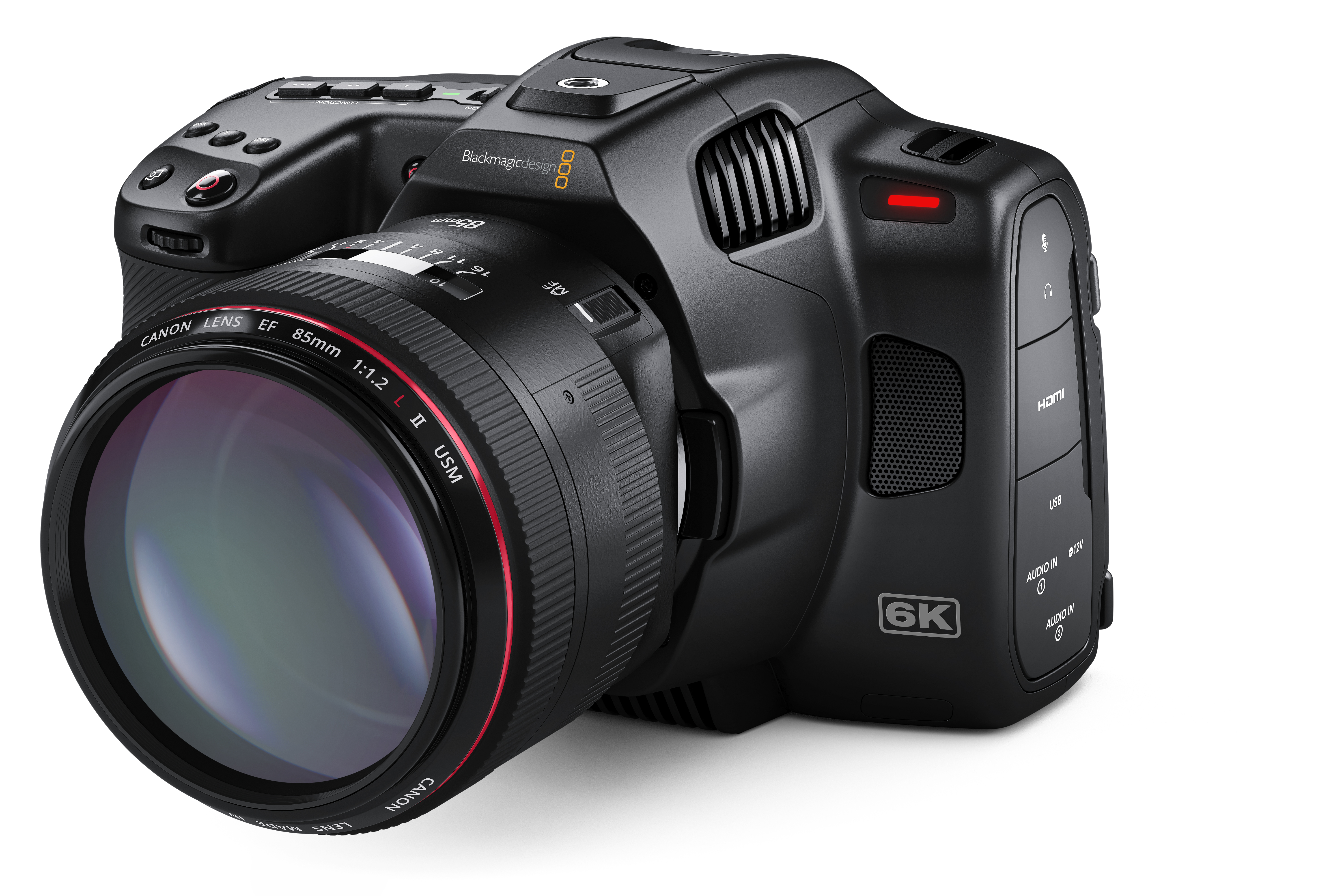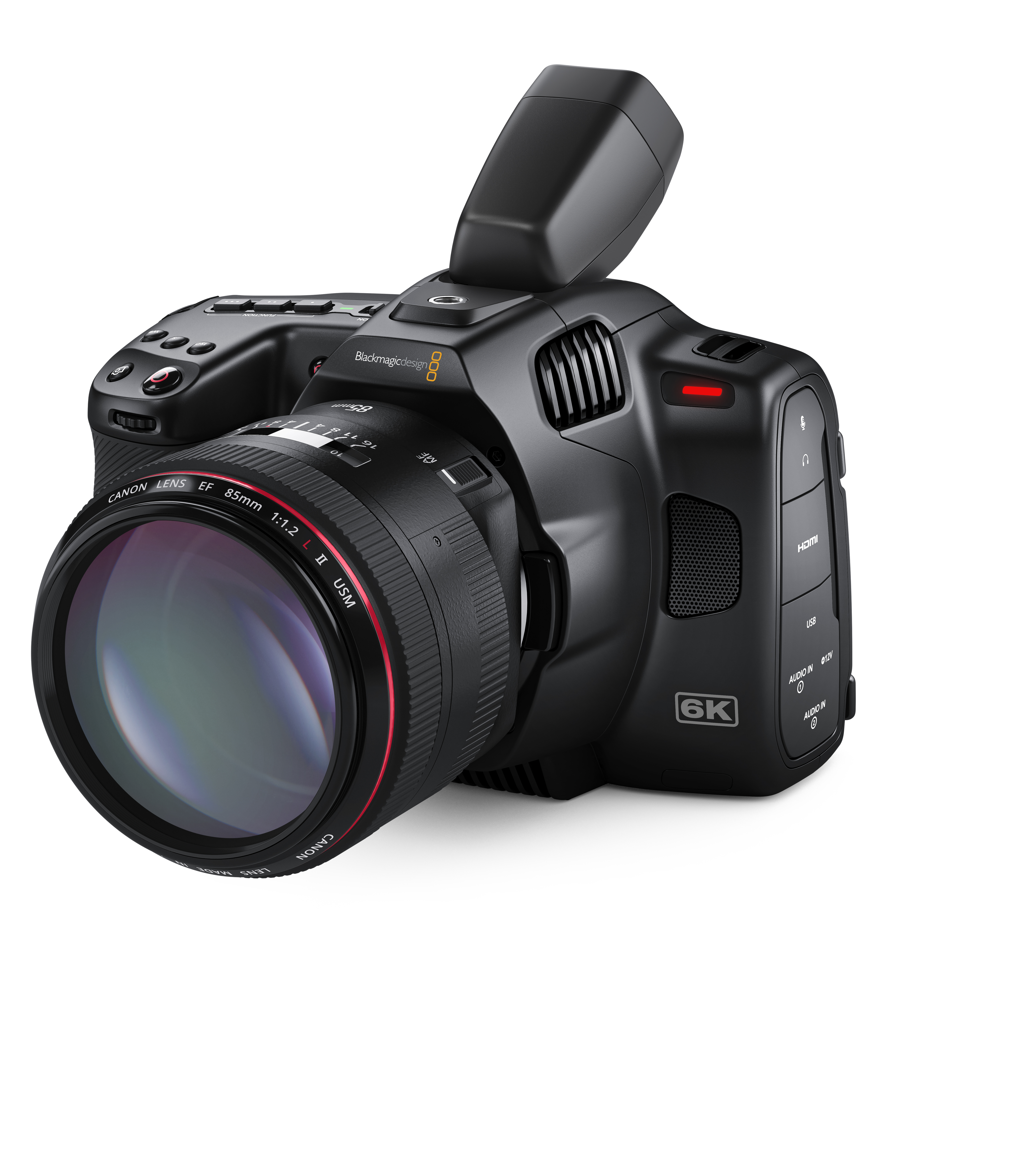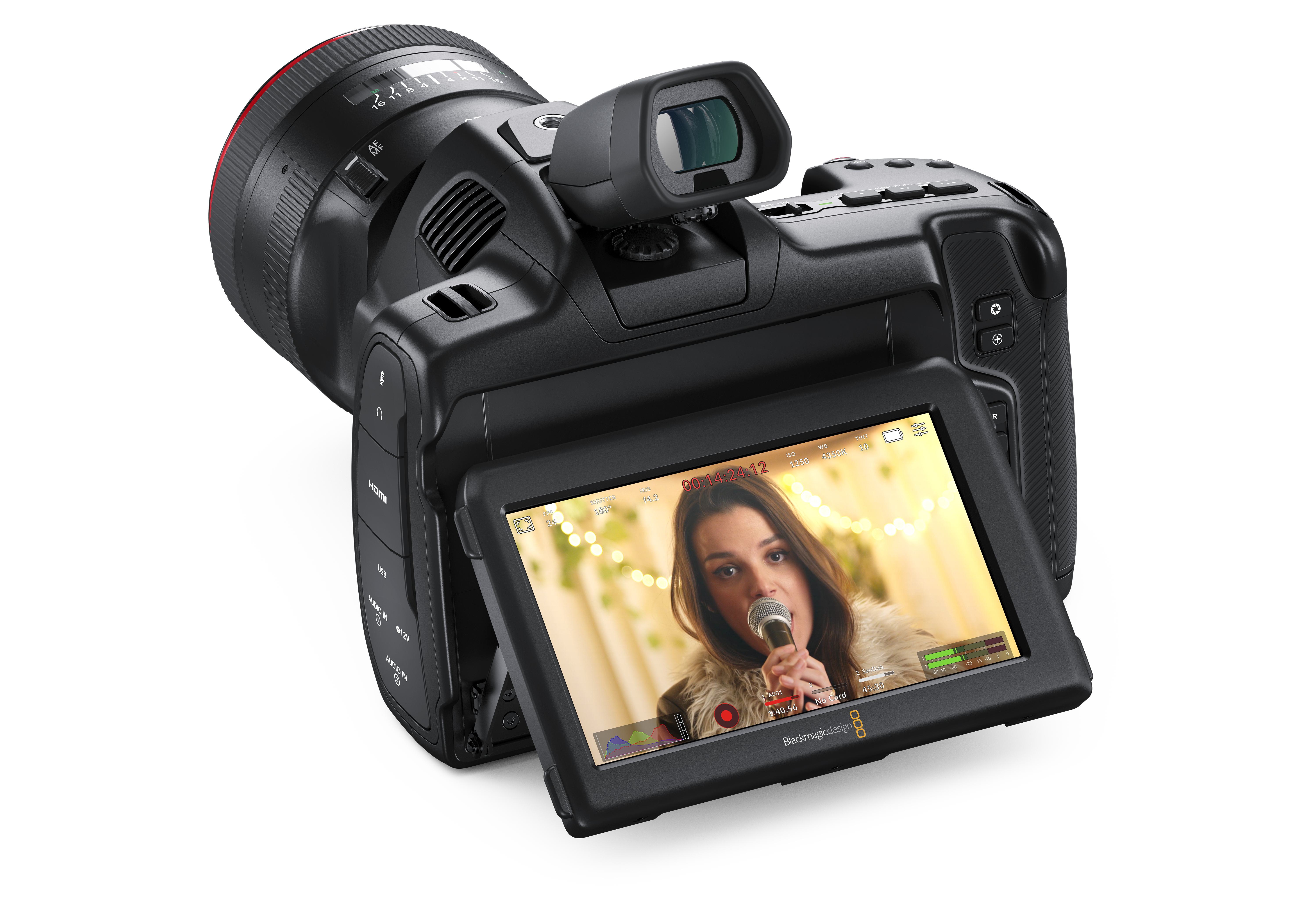Review: Blackmagic Design Pocket Cinema Camera 6K G2
The Pocket Cinema Camera 6K G2 is a very solidly built camera—much like a DSLR on steroids.

I’ve been using our university’s collection of Blackmagic Design’s Pocket Cinema Camera 6Ks for a few years and wanted to see how the lower-priced Pocket Cinema Camera 6K G2 held up to its older sibling. Blackmagic Design dropped the price of the Pocket Cinema Camera 6K in 2020, and then made Pocket Cinema Camera 6K G2 for the same price, but with more features.
Features
The Pocket Cinema Camera 6K G2 is a very solidly built camera—much like a DSLR on steroids. My review unit featured the five-inch tilting LCD touchscreen, three F570 batteries, the Blackmagic Pocket Camera Battery Pro Grip, and the optional electronic viewfinder
The Super 35 23.1 x 12.99mm HDR Gen 5 CMOS sensor sits behind a Canon EF mount that will accept a multitude of lenses. With recording options in Blackmagic RAW at 6144 x 3456 and 6144 x 2560 at 23.98 through 50fps; 5744 x 3024 from 23.98 to 60fps; 4096 x 2160, 3728 x 3104, and 2868 x 1512 at 23.98 through 29.97fps—you have many options. Within this, you must select your compression level in either Constant Bitrate’s 3:1, 5:1; 8:1; or 12:1; or Constant Quality’s Q0, Q1, Q3, or Q5. ProRes allows 4096 x 2160 and 3840 x 2160 up to 59.94fps and up to 119.88fps if using 1920 x 1080 at HQ, 422, LT or PXY compression.
The unit can record onto SD media (UHS-11), a CFast card, or and external SSD if the brand is on Blackmagic’s recommended media list. The storage media of choice will appear on the bottom right of the LCD screen.
The top of the camera has a slide on/off power switch, three customizable function keys, and buttons for ISO, Shutter, White Balance, Still Photo Capture and a Record button at the end of the hand grip. While holding the camera to shoot, the left-hand side has covered Microphone and Headphone mini jack inputs; HDMI; USB 3.1 input; 3-pin mini XLR Audio inputs 1 and 2; and the 12-volt DC input. The rear features the Iris and Focus buttons, High Frame Rate (HFR), Zoom, Menu, and Playback. You may also access many of these features on the five-inch tilting 1920 x 1080 LCD Touchscreen. The bottom has two tripod-mounting holes and the battery compartment.
When powered on, the on-screen menu offers tabs for Record, Monitor, Audio, Set-up, Presets, and LUTS—each with several options. Anyone who has used Blackmagic Design cameras in the past will be very familiar with these settings.
The optional accessories I received were the Blackmagic Pocket Cinema Camera Pro EVF which installs easily on the top of the camera and comes with several rubber eyepieces to suit the shooter’s needs, and the Blackmagic Pocket Camera Battery Pro Grip which houses two F570 batteries and mounts into the internal battery compartment with a few other minor adjustments. Both optional accessories are very handy, and I will discuss them in detail later.

Using the latest software update, the built-in gyro sensor allows moving images to be stabilized when shooting in Blackmagic RAW. The software utilizes this data and AI to greatly smooth out your shots. The gyro senses the data and stabilizes the footage in post.
In Use
Having the perfect film project lined up for the Pocket Cinema Camera 6K G2, I wanted to make sure I had indoor, outdoor, and shots that needed to be stabilized. As a big advocate of 6K RAW shooting, I set the camera to 6144 x 2560, 5:1, at 24 fps.
Using two different Canon EF mount lenses (16mm – 35mm f/2.8 and 24mm – 70mm f/2.8), I set out to shoot “Goodbye, Mr. Bonde” a six-minute short about an aging secret agent not quite ready to throw in the towel. The first exterior shoot would be the longest in the scorching and humid Pennsylvania August weather. I installed the Blackmagic Pocket Cinema Camera Pro EVF with the largest rubber eyepiece because seeing the LCD touchscreen would be difficult outdoors. When using the eyepiece, a sensor automatically shuts off the LCD screen saving battery drain. The optional viewfinder is worth every penny—especially when shooting outdoors. As mentioned earlier, if you have several different shooters the multiple eyepiece rubber cups will make everyone happy.
The Blackmagic Pocket Camera Battery Pro Grip held two batteries which greatly extended the shooting time – roughly an extra hour per battery. However, the grip does add a bit of weight if you intend to handhold the shot. On a tripod, you are just happy having a longer shoot with an extra battery. If you intend to switch back and forth with the grip and no grip, make sure you leave enough time to make the conversion. The LCD touch screen is the largest power draw, so having two batteries in the grip is helpful.

Removing the grip and switching back to the internal battery, I wanted to really test the Pocket Cinema Camera 6K G2’s stabilization capabilities. Instead of using the tripod for most shots, I had the actor walk into or out of the handheld shots. Greg, who is my human stabilizer, had his shots further refined by the camera’s gyro stabilized shots which we would see in post.
With several shots, he would handhold the camera and move slowly left or right knowing that the camera gyro feature in DaVinci Resolve would smooth everything out. I got about an hour of shooting time with one battery. One small nitpick—the batteries are charged by a USB cable connection rather than using AC. This might be more convenient for some, but it appears to add a lot to the charging time.
The rest of the shoot went well with Greg doing every moving shot asked of him. I personally prefer minor improvements to cameras rather than major overhauls. With the Pocket Cinema Camera 6K G2 it was as if I was wearing a favorite comfortable shoe. I know where everything was, what the camera could do, and the added peace of mind knowing that it would do it all well.
I had to install the latest version DaVinci Resolve 18 to edit the Blackmagic RAW files. Even though I shot in 6K, I used a 1920 x 1080 timeline set to center crop to edit the footage. The HD timeline speeds editing, and I still have the full 6K frame if I need to push into any shot. Anxious to stabilize the handheld footage, pulling down the camera gyro feature in Stabilization, I selected Analyze and it a few moments the shot was free of unnatural movement. That’s the fastest I have ever stabilized any shot!
There’s really a lot to rave about and very few complaints. When a product get better and the price drops—you can’t lose!
Application and Key Features
Multitude of Blackmagic RAW shooting formats, articulated LCD touch screen, user friendly interface, built in gyro stabilization—all from a company you can trust with a versatile camera package that does more for less.
Price – Available through Blackmagic Design authorized resellers
Blackmagic Pocket Cinema Camera G2 - $1995
Blackmagic F570 Battery (2) - $55 each
Blackmagic Pocket Camera Battery Pro Grip - $149
Blackmagic Pocket Camera Pro EVF - $495
DaVinci Resolve Studio – Included free with Pocket Cinema Camera6K Pro G2
Total Package - $2,639
Contact
Blackmagic Design USA
408.954.0500
Website: www.blackmagicdesign.com
E-mail: info-usa@blackmagicdesign.com
Get the TV Tech Newsletter
The professional video industry's #1 source for news, trends and product and tech information. Sign up below.
Chuck Gloman is Associate Professor with the TV/Film Department at DeSales University.

